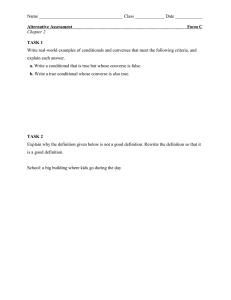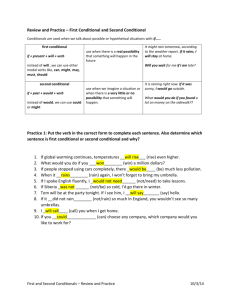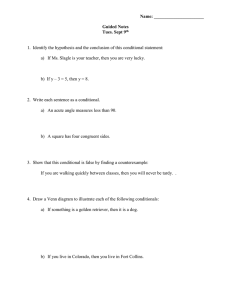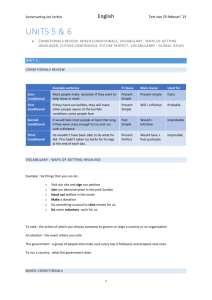Implementation of a Transformation System for Relational Probabilistic
advertisement
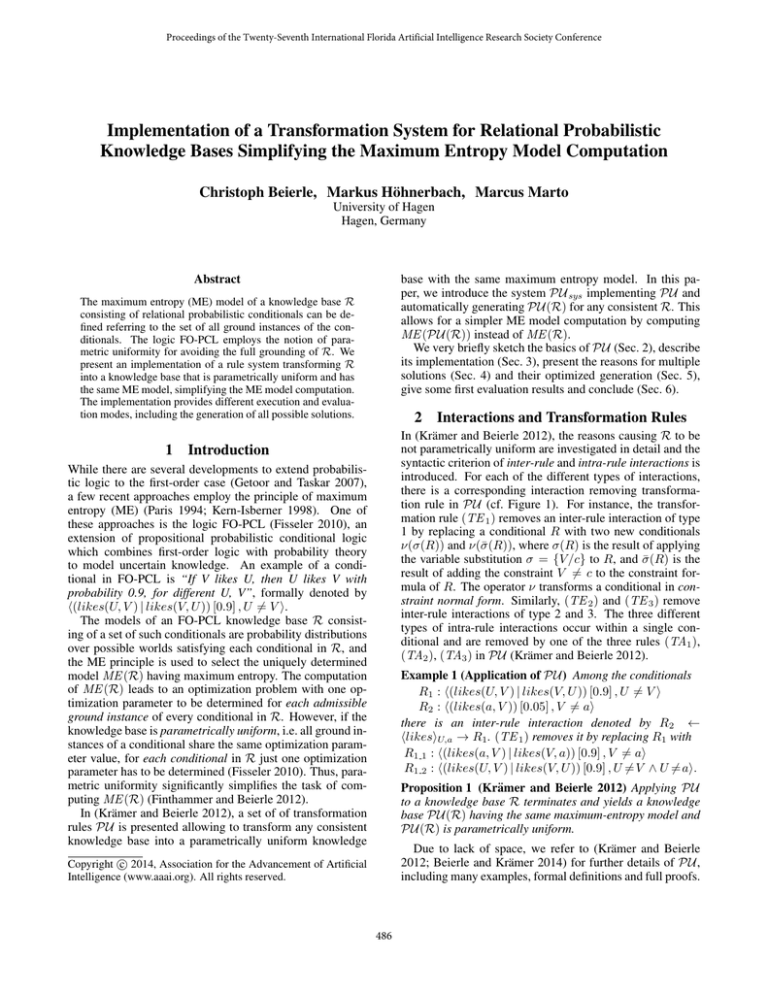
Proceedings of the Twenty-Seventh International Florida Artificial Intelligence Research Society Conference
Implementation of a Transformation System for Relational Probabilistic
Knowledge Bases Simplifying the Maximum Entropy Model Computation
Christoph Beierle, Markus Höhnerbach, Marcus Marto
University of Hagen
Hagen, Germany
Abstract
base with the same maximum entropy model. In this paper, we introduce the system PU sys implementing PU and
automatically generating PU(R) for any consistent R. This
allows for a simpler ME model computation by computing
ME (PU(R)) instead of ME (R).
We very briefly sketch the basics of PU (Sec. 2), describe
its implementation (Sec. 3), present the reasons for multiple
solutions (Sec. 4) and their optimized generation (Sec. 5),
give some first evaluation results and conclude (Sec. 6).
The maximum entropy (ME) model of a knowledge base R
consisting of relational probabilistic conditionals can be defined referring to the set of all ground instances of the conditionals. The logic FO-PCL employs the notion of parametric uniformity for avoiding the full grounding of R. We
present an implementation of a rule system transforming R
into a knowledge base that is parametrically uniform and has
the same ME model, simplifying the ME model computation.
The implementation provides different execution and evaluation modes, including the generation of all possible solutions.
1
2
Interactions and Transformation Rules
In (Krämer and Beierle 2012), the reasons causing R to be
not parametrically uniform are investigated in detail and the
syntactic criterion of inter-rule and intra-rule interactions is
introduced. For each of the different types of interactions,
there is a corresponding interaction removing transformation rule in PU (cf. Figure 1). For instance, the transformation rule (TE 1 ) removes an inter-rule interaction of type
1 by replacing a conditional R with two new conditionals
ν(σ(R)) and ν(σ̄(R)), where σ(R) is the result of applying
the variable substitution σ = {V /c} to R, and σ̄(R) is the
result of adding the constraint V 6= c to the constraint formula of R. The operator ν transforms a conditional in constraint normal form. Similarly, (TE 2 ) and (TE 3 ) remove
inter-rule interactions of type 2 and 3. The three different
types of intra-rule interactions occur within a single conditional and are removed by one of the three rules (TA1 ),
(TA2 ), (TA3 ) in PU (Krämer and Beierle 2012).
Introduction
While there are several developments to extend probabilistic logic to the first-order case (Getoor and Taskar 2007),
a few recent approaches employ the principle of maximum
entropy (ME) (Paris 1994; Kern-Isberner 1998). One of
these approaches is the logic FO-PCL (Fisseler 2010), an
extension of propositional probabilistic conditional logic
which combines first-order logic with probability theory
to model uncertain knowledge. An example of a conditional in FO-PCL is “If V likes U, then U likes V with
probability 0.9, for different U, V”, formally denoted by
h(likes(U, V ) | likes(V, U )) [0.9] , U 6= V i.
The models of an FO-PCL knowledge base R consisting of a set of such conditionals are probability distributions
over possible worlds satisfying each conditional in R, and
the ME principle is used to select the uniquely determined
model ME (R) having maximum entropy. The computation
of ME (R) leads to an optimization problem with one optimization parameter to be determined for each admissible
ground instance of every conditional in R. However, if the
knowledge base is parametrically uniform, i.e. all ground instances of a conditional share the same optimization parameter value, for each conditional in R just one optimization
parameter has to be determined (Fisseler 2010). Thus, parametric uniformity significantly simplifies the task of computing ME (R) (Finthammer and Beierle 2012).
In (Krämer and Beierle 2012), a set of of transformation
rules PU is presented allowing to transform any consistent
knowledge base into a parametrically uniform knowledge
Example 1 (Application of PU) Among the conditionals
R1 : h(likes(U, V ) | likes(V, U )) [0.9] , U 6= V i
R2 : h(likes(a, V )) [0.05] , V 6= ai
there is an inter-rule interaction denoted by R2 ←
hlikesiU,a → R1 . (TE 1 ) removes it by replacing R1 with
R1 1 : h(likes(a, V ) | likes(V, a)) [0.9] , V 6= ai
R1 2 : h(likes(U, V ) | likes(V, U )) [0.9] , U 6= V ∧ U 6= ai.
Proposition 1 (Krämer and Beierle 2012) Applying PU
to a knowledge base R terminates and yields a knowledge
base PU(R) having the same maximum-entropy model and
PU(R) is parametrically uniform.
Due to lack of space, we refer to (Krämer and Beierle
2012; Beierle and Krämer 2014) for further details of PU,
including many examples, formal definitions and full proofs.
c 2014, Association for the Advancement of Artificial
Copyright Intelligence (www.aaai.org). All rights reserved.
486
(TE 1 )
R ∪ {R1 , R2 }
R1 ← hP iV,c → R2 ,
R ∪ {R1 } ∪ ν{σ(R2 ), σ(R2 )} σ = {V /c}
(TE 2 )
R ∪ {R1 , R2 }
R1 ← hP iV,Z → R2 ,
R ∪ {R1 } ∪ ν{σ(R2 ), σ(R2 )} σ = {V /Z}
(TE 3 )
R ∪ {R1 , R2 }
R1 ← hP, QiV,Z → R2 ,
R ∪ {R1 } ∪ ν{σ(R2 ), σ(R2 )} σ = {V /Z}
(TA1 )
R ∪ {R}
R ∪ ν{σ(R), σ(R)}
hQiV,c → R,
σ = {V /c}
(TA2 )
R ∪ {R}
R ∪ ν{σ(R), σ(R)}
hQiV,Z → R,
σ = {V /Z}
(TA3 )
R ∪ {R}
R ∪ ν{σ(R), σ(R)}
hQ, SiV,Z → R,
σ = {V /Z}
4
The application of different transformation rules form PU
to a knowledge base R may lead to different parametric uniform knowledge bases (though still having the same
maximum entropy model due to Proposition 1), i.e. PU is
not confluent. The following knowledge base presented in
(Krämer 2011) illustrates this.
Example 2 Let R = {R1 , R2 } be the knowledge base with:
R1 : h(p(U, U ) | q(V )) [0.2] , U 6= V i
R2 : h(p(X, Y ) | q(W )) [0.3] , >i
There are three interactions in R:
Ia : R1 ← pX,Y → R2
Ib : R1 ← hp, qiX,W → R2
Ic : R1 ← hp, qiY,W → R2
Choosing first the interaction Ia and applying PU exhaustively yields the parametrically uniform knowledge base Ra
with the following four conditionals:
R1 : h(p(U, U ) | q(V )) [0.2] , U 6= V i
Ra2 : h(p(X, Y ) | q(W )) [0.3] , X 6= Y i
Ra3 : h(p(Y, Y ) | q(Y )) [0.3] , >i
Ra4 : h(p(Y, Y ) | q(W )) [0.3] , Y 6= W i
Choosing first the interaction Ib and applying PU exhaustively yields Rb with six conditionals:
R1 : h(p(U, U ) | q(V )) [0.2] , U 6= V i
Rb2 : h(p(Y, Y ) | q(Y )) [0.3] , >i
Rb3 : h(p(X, Y ) | q(X)) [0.3] , X 6= Y i
Rb4 : h(p(X, Y ) | q(Y )) [0.3] , X 6= Y i
Rb5 : h(p(Y, Y ) | q(W )) [0.3] , W 6= Y i
Rb6 : h(p(X, Y ) | q(W )) [0.3] , W 6= X ∧ W 6= Y ∧ X 6= Y i
Choosing first the interaction Ic and applying PU exhaustively yields a knowledge base Rc also with six conditionals;
in fact, Rc differs from Rb only by a renaming of variables.
Figure 1: Transformation rules PU (Krämer and Beierle
2012)
3
Multiple Solutions
Implementation
The software system PU sys implements the transformation
system PU. PU sys has been designed as a plug-in for
KR EATOR1 (Finthammer and Thimm 2012), which is an integrated development environment for relational probabilistic logic. The input knowledge base is parsed into an abstract
syntax tree from which an object structure is created. The
recognition of interactions and the application of the transformation rules operate directly on this structure. A transformation process can be started by executing a KR EATOR
script (Finthammer and Thimm 2012). All transformation
parameters (e.g. transformation mode) can be set either by
using a graphical user interface or within the script itself.
Transformation Modes PU sys ensures that all conditionals of the initial knowledge base are transformed into
constraint-normal form. If more than one interaction is
found, one of these interactions has to be selected for the
application of the corresponding transformation rule. Therefore, PU sys offers different transformation modes for different rule application strategies.
The Interactive mode allows to control, monitor and trace
single steps of a transformation process through a graphical
user interface. In the Automatic mode, an applicable transformation rule is selected automatically and applied until
a parametrically uniform knowledge base is reached. The
All Solutions transformation mode creates all results that are
obtainable by applying different orders of rule applications.
Thereby, it avoids the multiple generation of the same parametrically uniform knowledge base, and moreover, it avoids
the generation of knowledge bases that are just variants of
each other with respect to variable renamings. As this mode
is of particular interest when investigating properties of PU
related e.g. to minimal solutions or confluence properties,
this mode will be described in more detail in Sec. 5.
Thus, even when taking variable renamings into account,
in Example 2, PU can transform R into two different parametrically uniform knowledge bases, Ra and Rb . Here, the
choice of the interaction that gets removed first determines
the solution, while in general, the splitting in different solutions may occur at any stage of the transformation process.
5
Generation of all Solutions
Enumerating all solutions in a simple way by branching out
every time there is more than one option which interaction to
remove first, is not feasible even for small knowledge bases.
It would also give no information about the number of solutions that differ in more than a variable naming. Knowledge
bases obtained by PU whose conditionals differ only in variable naming are equivalent. The source for this ambiguity in
the transformation process is that an equivalence constraint
A = B can be realized in a substitution A/B as well as B/A
if A and B are both variables.
Definition 1 (pt-equivalent conditionals) Let R be a
knowledge base, R ∈ R, and let σ = σn ◦ . . . ◦ σ1 and
0
σ 0 = σm
◦ . . . ◦ σ10 be substitutions obtained from applying
two sequences of PU transformations to R. Then the
1
Source code of KR EATOR and PU sys can be found at
http://kreator-ide.sourceforge.net/
487
conditionals σ(R) and σ 0 (R) are equivalent with respect
to PU transformations (or just pt-equivalent) iff there is a
variable renaming ρ such that ρ(σ(R)) = σ 0 (R).
row contains the six conditionals obtained by applying the
corresponding interaction removing transformations. The
fourth row contains the substitution nodes corresponding
to the interactions among the conditionals in the third row.
Note that three of the resulting conditionals in the fifth row
have multiple incoming edges since, up to pt-equivalence,
they can be generated in different ways.
Note that this notion is relative to the root conditional R.
For instance, in Example 2, the two conditionals
R20 : h(p(X, X) | q(X)) [0.3] , >i
R200 : h(p(Y, Y ) | q(Y )) [0.3] , >i
originating from R2 with the substitutions W/X and Y /X
respectively W/Y and X/Y are pt-equivalent as there is
ρ = X/Y such that ρ(R20 ) = R200 .
An algorithm to find the solutions has to make two choices
during the process:
This operation effectively transforms the graph from a
tree to a directed acyclic graph. This graph can now answer the question Q1 posed before: The substitution nodes
denote exactly the substitutions that can be applied to its parent conditional node during the interaction removal process.
In order to answer question Q2 , the auxiliary graph is reduced by identifying and removing redundancies caused by
substitution nodes. For instance, let R ∈ R be a conditional
that has two interactions in R with interaction removing substitutions σ1 , σ2 . Assume that those are independent, i.e.
removing one interaction changes nothing about the other
interaction. Then the graph will contain both σ1 and σ2 as
substitution nodes below R. As these are independent from
each other, σ2 is also a substitution child node of σ1 (R) as
well as σ¯1 (R) and vice-versa. Thus, both substitution nodes
σ1 and σ2 below R lead to the same conditionals below, and
we can fuse the two substitution child nodes of R to one substitution node {σ1 , σ2 } and pick an arbitrary representative
determining the edges. Removing all such redundancies in
a bottom-up manner yields the reduced auxiliary graph.
Q1 : What conditionals should be checked for interactions?
Q2 : Which transformations should be executed on these
conditionals ensuring that all solutions are generated?
The algorithm introduced in this paper to answer Q1 and
Q2 uses an auxiliary graph which is essentially a representation for the set of knowledge bases reachable through the
transformation process. It is a directed graph with two types
of nodes: conditional nodes representing a single conditional, and substitution nodes representing a substitution acting on a conditional. The nodes are connected such that conditional nodes are connected to their respective interactionremoving substitution nodes, and substitution nodes are connected to the conditional nodes that are the result of applying
said substitution to the parent conditional.
Example 5 Fig. 2(c) shows the reduced graph for R from
Example 2. Note how there is just one conditional node with
more than one substitution child node, corresponding to R2 .
Example 3 Fig. 2(a) is is an auxiliary graph representing
the solution knowledge base Rb from Example 2. On the top
level there are the conditionals of the original knowledge
base (rectangles). Below these there are the interactionremoving substitutions σ (ellipses) connected to the conditional node R they apply to, and to the two resulting conditional nodes σ(R) and σ̄(R). Thus, each substitution node
has exactly one incoming and two outgoing edges. The conditionals in Rb are precisely the six leaf nodes in the graph.
The reduced graph can be used to determine which
interaction-removing substitutions on a given conditional
are sufficient for generating all solutions. Starting with the
set M containing the conditional nodes in the first row of the
graph (i.e., the set of conditionals in the original knowledge
base), do the following: While there is a conditional node C
in M that is not a leaf node, choose (non-deterministically)
one of C’s child substitution nodes and replace C in M by
the two child nodes of the chosen substitution node.
Such an auxiliary graph can also be constructed for the
whole transformation process behind PU. The algorithm
starts with the empty graph and adds a conditional node for
each conditional in the initial knowledge base. Then we successively pick one conditional node, compute the set of conditional nodes in the graph that it can possibly interact with,
check for interactions with said nodes and add the corresponding substitution nodes for the found interactions.
When the substitution node gets added, we also have
to connect its outgoing edges. At this point we use the
equivalence between conditionals from Definition 1 to check
whether a pt-equivalent conditional is already contained in
the graph. If this is the fact, then it suffices to connect the
substitution node to said conditional node, and we do not
have to add a new conditional node to the graph.
Example 6 As there is only one conditional node in the reduced graph in Fig. 2(c) (i.e. R2 ), there is only one (nondeterministic) choice to be made. Thus, the graph represents exactly the two parametrically uniform solutions Ra
and Rb (cf. Example 2) which correspond to the leave nodes
obtained by choosing either the left substitution child node
X/Y or the right substitution child node X/W of R2 .
6
First Evaluation Results and Further Work
PU sys has been applied successfully to many different
knowledge bases, including all examples given in (Fisseler
2010; Krämer and Beierle 2012; Finthammer and Beierle
2012) and a series of randomly generated examples, covering all types of interactions. The optimized generation of
all solutions is much more efficient than the naive approach,
e.g., generating exactly the two solutions for R as in Ex. 2,
compared to 28 solutions in the naive approach, or yielding
all non-redundant solutions within seconds where the naive
Example 4 Fig. 2(b) is the auxiliary graph corresponding
to the knowledge base R from Example 2. In the first row,
there are the conditionals of the original knowledge base R,
and the second row contains the substitution nodes corresponding to the three interactions Ia , Ib , Ic in R. The third
488
(a)
R1 : h(p(U, U ) | q(V )) [0.2] , U 6= V i
R2 : h(p(X, Y ) | q(W )) [0.3] , >i
X/W
Rb2 : h(p(Y, Y ) | q(Y )) [0.3] , >i
h(p(X, Y ) | q(X)) [0.3] , >i
h(p(X, Y ) | q(W )) [0.3] , W 6= Xi
X/Y
W/Y
Rb3 : h(p(X, Y ) | q(X)) [0.3] , X 6= Y i
Rb4 : h(p(X, Y ) | q(Y )) [0.3] , X 6= Y i
h(p(X, Y ) | q(W )) [0.3] , W 6= X ∧ W 6= Y i
X/Y
Rb5 : h(p(Y, Y ) | q(W )) [0.3] , W 6= Y i
(b)
h(p(X, Y ) | q(W )) [0.3] , >i
X/Y
h(p(X, Y ) | q(W )) [0.3] , X 6= Y i
Y /W
h(p(U, U ) | q(V )) [0.2] , U 6= V i
X/W
h(p(Y, Y ) | q(W )) [0.3] , >i
h(p(X, Y ) | q(Y )) [0.3] , >i
h(p(X, Y ) | q(X)) [0.3] , >i
Y /W
X/Y
X/Y
h(p(Y, Y ) | q(Y )) [0.3] , >i
h(p(X, Y ) | q(W )) [0.3] , W 6= X ∧ X 6= Y i
Y /X
h(p(Y, Y ) | q(W )) [0.3] , W 6= Y i
(c)
h(p(X, Y ) | q(X)) [0.3] , X 6= Y i
h(p(X, Y ) | q(W )) [0.3] , W 6= Xi
X/Y
h(p(X, Y ) | q(Y )) [0.3] , X 6= Y i
h(p(X, Y ) | q(W )) [0.3] , W 6= Y ∧ W 6= Xi
h(p(X, Y ) | q(W )) [0.3] , W 6= Y i
X/Y
X/W
h(p(X, Y ) | q(W )) [0.3] , W 6= Y ∧ X 6= Y i
X/W
h(p(X, Y ) | q(W )) [0.3] , W 6= Y ∧ X 6= Y ∧ W 6= Xi
h(p(X, Y ) | q(X)) [0.3] , X 6= Y i
h(p(U, U ) | q(V )) [0.2] , U 6= V i
X/Y
X/W ; (Y /W )
h(p(Y, Y ) | q(W )) [0.3] , >i
h(p(X, Y ) | q(X)) [0.3] , >i
h(p(X, Y ) | q(W )) [0.3] , W 6= Xi
X/Y
Y /W
X/Y ; (Y /W )
h(p(Y, Y ) | q(Y )) [0.3] , >i
Y /W
Y /W
h(p(X, Y ) | q(W )) [0.3] , >i
h(p(X, Y ) | q(W )) [0.3] , X 6= Y i
Rb6 : h(p(X, Y ) | q(W )) [0.3] , W 6= X ∧ W 6= Y ∧ X 6= Y i
h(p(Y, Y ) | q(W )) [0.3] , W 6= Y i
h(p(X, Y ) | q(W )) [0.3] , W 6= X ∧ X 6= Y i
Y /W
h(p(X, Y ) | q(Y )) [0.3] , X 6= Y i
h(p(X, Y ) | q(W )) [0.3] , W 6= Y ∧ X 6= Y ∧ W 6= Xi
Figure 2: (a) Auxiliary graph for Rb , (b) auxiliary graph for R, and (c) reduced auxiliary graph for R from Example 2
approach does not terminate within four hours. Our current
work also includes the question whether PU can be modified
such that a confluent set of transformation rules is obtained.
Fisseler, J. 2010. Learning and Modeling with Probabilistic
Conditional Logic, volume 328. Amsterdam: IOS Press.
Getoor, L., and Taskar, B., eds. 2007. Introduction to Statistical Relational Learning. MIT Press.
Kern-Isberner, G. 1998. Characterizing the principle of minimum cross-entropy within a conditional-logical framework.
Artificial Intelligence 98:169–208.
Krämer, A., and Beierle, C. 2012. On lifted inference for
a relational probabilistic conditional logic with maximum
entropy semantics. In FoIKS 2012, volume 7153 of LNCS,
224–243. Springer.
Krämer, A. 2011. Transformation rules for lifted inference
in relational probabilistic logic knowledge bases. B.Sc. Thesis, FernUniversität in Hagen, Germany.
Paris, J. 1994. The uncertain reasoner’s companion – A
mathematical perspective. Cambridge University Press.
References
Beierle, C., and Krämer, A. 2014. Achieving parametric
uniformity for knowledge bases in a relational probabilistic
conditional logic with maximum entropy semantics. Annals
of Mathematics and Artificial Intelligence. (to appear).
Finthammer, M., and Beierle, C. 2012. How to exploit parametric uniformity for maximum entropy reasoning in a relational probabilistic logic. In JELIA 2012, volume 7519 of
LNAI, 189–201. Springer.
Finthammer, M., and Thimm, M. 2012. An integrated development environment for probabilistic relational reasoning.
Logic Journal of the IGPL 20(5):831–871.
489
